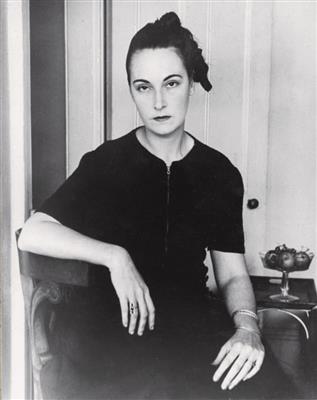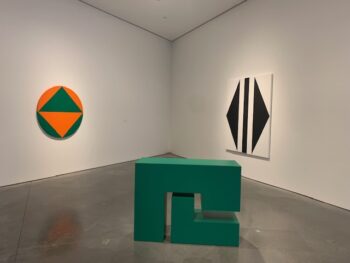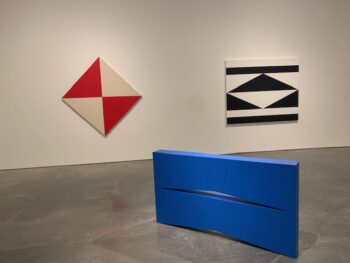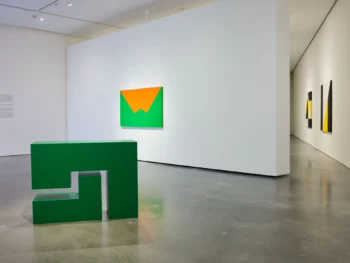By Brian Nixon —
Cuban American artist, Carmen Herrera, was 106 when she died. And other than a few splashes of recognition in her long career, she spent most of her life creating marvelous hard-edge paintings without the praise of curators, critics, or the public. In other words, she remained largely anonymous. That changed in 2004. Her neighbor and fellow-artist, Tony Bechara, told a gallery about her. The rest is history. For the remaining twenty years of her life, she received the respect she deserved, gallery exhibitions, news interviews, articles, books, and documentaries on her life and work. Netflix’s The 100 Years Show brought Herrera’s work to a mass audience.

I was first introduced to Herrera’s work in 2016 via a CBS’s Sunday Morning newscast. As an admirer of hard-edge painting (I write about Frederick Hammersley in my book Tilt), I was amazed that an artist of Herrera’s quality went largely unknown throughout most of her life. Some claim the bias was because of her sex, a woman; others say her nationality, a Cuban; still others point to politics. Here’s how the museum SITE Santa Fe positioned the cause:
“Despite her undeniable talent, movements such as Minimalism and Abstraction were largely dominated by men, often overshadowing invaluable contributions by women like Herrera…This delayed recognition sheds light on persistent challenges in the art world today. Being a female Latina artist and an immigrant, Herrera faced discrimination, particularly during the 1950’s and 60’s, while living and working in New York.”

Herrera was born in 1915 in Havana, Cuba. The daughter of journalists, she was the youngest of seven children. She married American English teacher, Jesse Loewenthal, and moved to America. Famed writer, Frank McCourt—author of Angela’s Ashes— was a friend of Lowenthal’s. McCourt described Jesse as an “old-world scholar in an ‘elegant, three-piece suit…’” From the time of her birth to her death in New York in February 2022, her life was spent creating marvelous art, the offspring she bore, having no children of her own.
An important facet to note about Herrera is that she was a believer, attending church regularly at the Church of the Epiphany. According to the Art Story—in commenting upon her painting The Way—“Herrera was born and raised Catholic, and has kept her faith throughout her life, filling her house with religious iconography.” In an interview with The Guardian Herrera notes that she was born in a Christian household and will die a Christian, though she states, there “a lot of things I question…”
To my knowledge Herrera didn’t analyze her art from a theistic perspective, but from an aesthetic point of view, positioning its worth as a thing of beauty, visual and intellectual inspiration.
This said, at recent exhibition of her work at SITE Santa Fe entitled I’m Nobody! Who Are you?, a title derived from an Emily Dickinson poem, I was struck by three aspects of her art that did cause me to think theistically about her work.

The Beauty of Her Lines. For me, lines signify a beginning and an end, pointing to the nature of life, history, and the cosmos. Most things have a start and a finish. The line is one of the simplest forms to represent this fact, a one-dimensional, formless object. Herrera’s lines are marvelous— tight, clean, and ordered. Straight lines are a very human construction, with nature having very few (if any) perfectly straight lines.
In other words, lines are a mathematical reality used by humans to define and delineate, to help describe. Concerning the line, SITE Santa Fe wrote, “Herrera was in love with the line. She considered lines not only the building blocks of all shapes and forms, but also the power to construct, connect, simplify, and define.”
SITE quotes her as saying, “I never met a straight line I did not like.” Lines also position us in relation to God. Classical theology teaches that only God is eternal, having no beginning or end. Maybe this is why theists portray God as a circle or trefoil (three interlocking circles) in opposition to the line. God is concurrently and everlasting alive, with no beginning or end, the eternal now. God is the Necessary Being that affords being. God is the circle to human lines. Because of this, lines remind me of human temporality. Furthermore, as Herrera states in an interview, there’s “beauty of the straight line.” I agree: Lines are lovely. Consequently, there is beauty in what the line symbolizes, our being, our delineation and description of what it means to be human.

The Geometrical Order. Walking the exhibit in Santa Fe, one thing is clear: geometrical patterns and shapes are a key visual elements of Herrera’s art. A shape is the form of an object. One can find triangles, squares, rectangles, and everything in between and beyond. Along with the line (inherent in geometrical patterns), shape and form play a vital role in Herrera’s aesthetic vocabulary.
Of the eleven paintings represented (and two sculptures), there was not an exact repeated geometrical pattern. All her work was orderly, refined, and well designed. Whether or not it was Herrera’s intention, order is a clue to God’s design of the cosmos, known as teleology. In theology, teleology has two aspects. One, the purpose something serves. Two, something’s design, order, and form. As an example, the fork. The fork’s purpose is to help humans eat. Its design and form consist of slots, tines, points, roots, neck, and handle, a well-ordered, crafted item to serve its intended purpose. Teleologically, Herrera’s art is methodical, systematic, and mathematical, with each geometric pattern having a unique imprint. And for me, Herrera’s art served a purpose: to challenge and delight. Teleological patterns prevail in Herrera’s art, as they do in God’s creation, a Designer to design.

The Interplay of Color. I counted nine colors represented in Herrera’s exhibit. However, flipping through the book at SITE Santa Fe—many more abound. The colors used are vivid, diverse, and delightful. From black, yellow, red, greed, blue, orange and white—to cornucopia of colors. Along with line and shape, color is a prominent feature of her art, affecting the viewer in a multitude of ways.
According to the London Image Institute, color has an effect on humans, creating a “Color Psychology.” In the article, it’s noted there are “psychological connotations between colors and emotions.” As an example, red—conjures excitement, love, and energy; orange—confidence, bravery, and success; blue—trust, peace, loyalty. In other words, colors color our consciousness, influencing how we think and feel.
As an example, Mental Health America suggests to use “bright, warm colors to stimulate energy.” Like Herrera’s use of color, color diversity is a clue to God’s creativity, His desire to fill the world with play, festivity, and beauty, moving us with magnificent hue. In classical theology, God is simple (unified), yet has diverse attributes, an interpenetration of characteristics. God is like a Prism that casts light, showering the world in extraordinary colors, affecting and influencing us in manifold ways. Colors suggest a creative Creator, as Herrera’s color conjoins the viewer to her creative outlook.
In pondering Herrera’s work, I’m reminded of a quote by Arthur Balfour, “We are unable to estimate works of art as they are in themselves, not because we must buttress up our opinions by extraneous and irrelevant considerations; but rather because a work of art requires an artist, not merely in the order of natural causation, but as a matter of aesthetic necessity.”[1]

However one “estimates” Herrera’s work (whether you like it or not), the fact that Carmen Herrera felt it necessary to paint shapely, colorful works of art for roughly ninety years may be the greatest lesson for us all: an inborn calling to create, to express, to fashion something new, invoking pleasure, delight, challenge, and an appreciation of the artists’ purpose, entreating a revelation of the senses. Like God is to His handiwork, an Artist to art, Herrera is to the necessity of her art, an act of the heart.
[1] Balfour, Theism and Humanism, p. 67.



